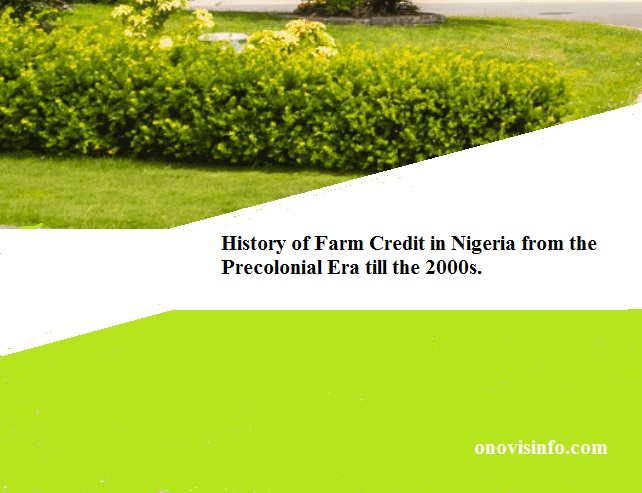History of Farm Credit in Nigeria from the Precolonial Era till the 2000s.
The Precolonial Area
The history of farm credit in Nigeria can be traceable to the pre-colonial era when agricultural activities were based on the use of crude and locally fabricated farm implements.
Farm credit was basically through an informal method where farmers exchanged farm products for products and animal for animal.
During the farming season, the farmers in the communities exchange planting materials and animals with one another as well as farm implements to aid agricultural production.
The Colonia Era
Farm credit began to gain more prominence during the colonial era when the British colonial administration began to support farmers with financial assistance to aid the cultivation of cash crops such as cocoa, oil palm, rubber, and groundnut for export to other countries.
In 1928, the colonial government introduced the Agricultural Credit Ordinance to aid farmers in having access to short-credit, medium, and longer-term credit facilities.
The ordinance stipulated that a small percentage of public funds be voted to assist farmers with agricultural loans on favorable terms to enable farmers to secure credit for the security of farming stock and agricultural assets.
The ordinance was able to support farmers with loans for the cultivation of export crops but did not achieve much because it was marred by inadequate farmers’ access to credit facilities, and the focus was majority on the cultivation of cash crops resulted in the neglect of arable crops.
Post Independent Era
From 1963 to the 1970s, immediately after Nigeria became a republic, the government of Nigeria made a frantic effort to increase food production and carry out more investment in agriculture in a bit to modernize agriculture in Nigeria.
In 1973, the government of Nigeria introduced the Nigerian Agricultural and Cooperative Bank which is known today as the Nigerian Agricultural Bank to provide credit to farmers including small-scale farmers and agricultural institutions,
Other agricultural program that was introduced during this period included the National Accelerated Food Production Programme (NAFPP), Operation Feed the Nation (OFN), and Green Revolution Revolution, with emphases on financial support to small and medium-scale farmers to boost food production in Nigeria.
In the 1980s, the Former Nigerian president Ibrahim Babangida adopted the Structural Adjustment Programme (SAP) in Nigeria as part of Nigeria’s economic reforms.
The aims of the scheme are to improve trade policies, and foreign exchange, encouraging private business participation, and agricultural reforms. The structural adjustment program was introduced as a measure to reduce government participation in agriculture and encourage private participation in agriculture.
The structural adjustment program in Nigeria led to the involvement of private financial institutions, e.g., commercial banks and micro-finance banks which have become the major financial sources for small and medium scale farmers in Nigeria.
In a way to boost agricultural development in Nigeria, the government introduced the Agricultural Credit Guarantee Scheme Fund (ACGSF) in 1987 to help provide guaranteed funds to banks and credit agencies to provide financial credit to farmers.
The scheme was able to achieve a lot of progress in granting to loan farmers and for agricultural development in the country. But immediately after the federal government started financial deregulation, many financial institutions reduced their emphasis on the scheme, which led to the inability of banks to grant loans to aid agricultural development.
From 1990s – 2000s
Successive Nigeria government has introduced many agricultural programs such as the Agricultural Development Program, River Basin and Rural Development Authority, and agricultural food production program aimed at supporting farmers with agricultural credit and grants to aid food production.
During this period many agricultural credit initiatives and reforms were introduced by the federal government into the agricultural system to improve access to farm credit by farmers. The central banks of Nigeria introduce various financial programs to help farmers have access to credit facilities, some of these programs are Agricultural Credit Support Scheme (ACSS), and Commercial Agriculture Credit Scheme (CACS).
In 2010 the federal government established the Nigerian Incentive-Based Risk Sharing System for Agricultural Lending (NIRSAL) with the aims of providing insurance coverage for agriculture, agriculture financial and investment providers, improving financial institutions and agricultural value chain players for effective performance.
From 2010 till date
To diversify the economy various agricultural programs and reforms aimed at providing financial credits to farmers have been launched such as the Anchor Borrowers Program with the objectives of
increasing the financing of financial banks to improve agricultural productivity, driving value chain financing, financing assistance smart agriculture, and agriculture from subsistence to commercial farming to through adequate financing.
The federal government through the central banks of Nigeria has introduced various reforms in the financial system to include financial technology (fintech) which will enable small, medium, and large-scale farmers to access credit facilities in the rural areas even from their mobile banking apps and their phone numbers.
References
Agricultural Credit Guarantee Scheme Fund (ACGSF, 1987). retrieved from https://www.cbn.gov.ng/Devfin/acgsf.asp
Central Bank of Nigeria (2017) Guidelines for Applying for Encore Borrow Scheme: Retrieved from https://www.cbn.gov.ng/Out/2021/CCD/ABP%20Guidelines%20October%2013%202021%20-%20Final%20(002).pdf
Nigerian Incentive-Based Risk Sharing System for Agricultural Lending (NIRSAL, 2010) Cooperate File,. Retrieved from https://nirsal.com/wp-content/uploads/2021/05/NIRSAL-Company-Profile-.pdf#:~:text=The%20Nigeria%20Incentive-Based%20Risk%20Sharing%20System%20for%20Agricultural,Share%20agribusiness-related%20credit%20risk%20with%20%EF%AC%81nanciers%20and%20investors.
